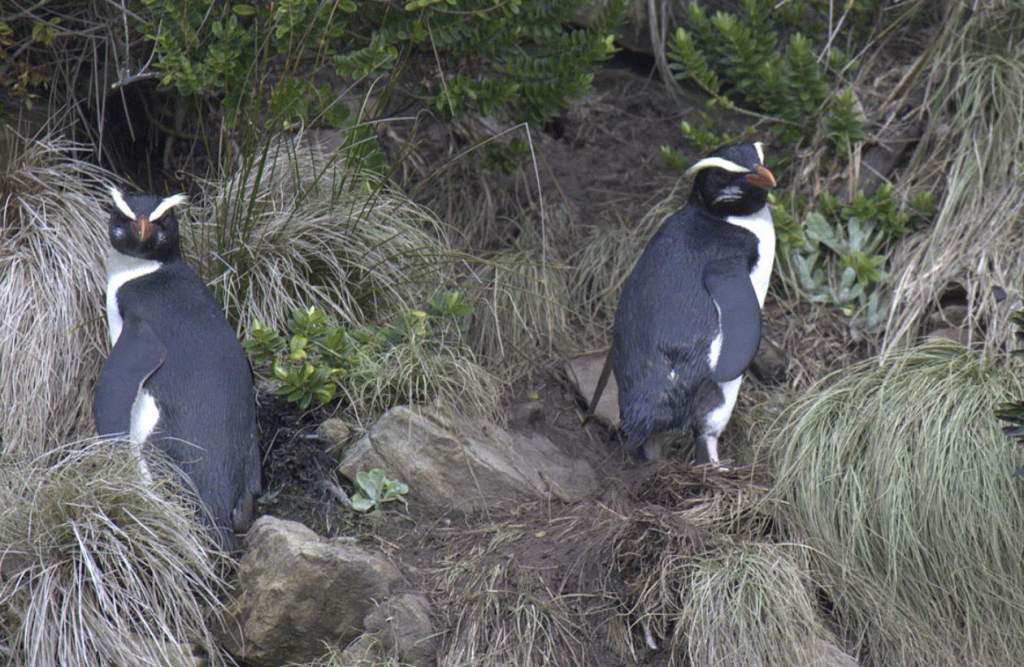The Fiordland Penguin’s (Eudyptes pachyrhynchus) head adornments most likely assist swimming birds in recognizing individuals of their species, as the head is typically the only part of the body visible above water.
Facial signals are also crucial during courtship rites, and they are reinforced by waving the flippers’ black-edged undersurfaces. Fiordland penguins breed in late winter and early spring. However, remember that as the season lengthens, chicks go as late as early December. The direction of food-bearing waters, surface sea temperatures, and currents all likely influence the migration patterns of Fiordland Penguins.
Habitat: The exact circuit of the migration is not known. Stragglers have reached the Campbell and Auckland Islands, the Snares Islands in the sub-antarctic, the far northern peninsula of the North Island of New Zealand, and even Western Australia. In recent years, increased beach searching by ornithologists has resulted in many finds of beach-washed living and dead Fiordland Penguins in Tasmania and the southern mainland. This is the only species of crested penguin regularly breeding on the mainland islands of New Zealand.
It feeds along the coast during the mating season, then molts on land in the summer before dispersing during the autumn and winter. Most Australian discoveries have occurred during the winter months of this dispersal, or occasionally in January and February, when birds that do not return to New Zealand in time to molt on land come ashore on Australian beaches seeking refuge. Because there are numerous records from the Victorian and Tasmanian coasts, penguins may be concentrated just east of Australia, possibly just beyond or along the edge of the continental shelf and stretching eastward to New Zealand.
Penguins frequently build their nests amid the roots of trees in coastal woods, within small caves, or beneath overhanging banks. Nests are generally split into informal groupings. Only Big Solander and Open Bay Island have conspicuous breeding colonies. Fiordland Penguins lay two eggs, and both parents help incubate, guard, and feed the babies.

Diet: These birds eat small fish, mollusks, and crustaceans.
Predators: The major predators of the Fiordland Penguin are Giant Petrels, Southern Skuas, sea lions, fur seals, and perhaps sharks and killer whales. On land, they might fall prey to cats, dogs, foxes, and humans.
Alternative Names: It is also called the thick-billed penguin or crested penguin.
Size: The Fiordland Penguin is about 520–700 mm in length.
Identification: Both adults are similar; however, the female is slightly smaller. Blue-grey to blue-black above; upper side of flippers blue-grey. Underparts satin-white; under flipper white with broad black base and tip. Tail of long, stiff, blue-black, almost spiny feathers. Head and throat are blue-grey to blue-black, dusky on cheeks, where there are often several conspicuous white stripes. Eyebrow stripes a white to straw-yellow crest, reaching bill and drooping far back behind the ear region.
Eyes are usually bright red. Massive bill: red-orange or red-brown. Feet and webbed toes are pale pink; nails and soles are black. The immature bird is similar to adults, but its cheeks are chocolate brown to black. Eyebrow stripe-crest of shorter feathers, paler. The chin and throat are almost white. The downy young is dusky brown from head and throat over back; breast and belly are dull white.
Vocalizations: There are a variety of guttural to shrill gurgling calls, uttered during courtship, when fighting, or as contact calls when swimming in flocks.
Nesting: The nesting and breeding occur in late winter and early spring to October, but sometimes longer. Chicks may be present till early December. Nest of debris, stones, and feathers.
Eggs and Incubation: The Fiordland Penguin lays two eggs, dull white with a slight green tinge, ovoid, the first averaging 67 x 52 mm, normally slightly smaller than the second, 71 x 55 mm. The incubation responsibilities are shared by both sexes.
Distribution: Many records from Tasmanian and Victorian beaches in recent years; also more than five from Western Australia, three from South Australia, and two from New South Wales. Breeds in New Zealand.
Races: There are no races.
Read More: Rare Golden Penguin Spotted Along the Shore of Antarctica







